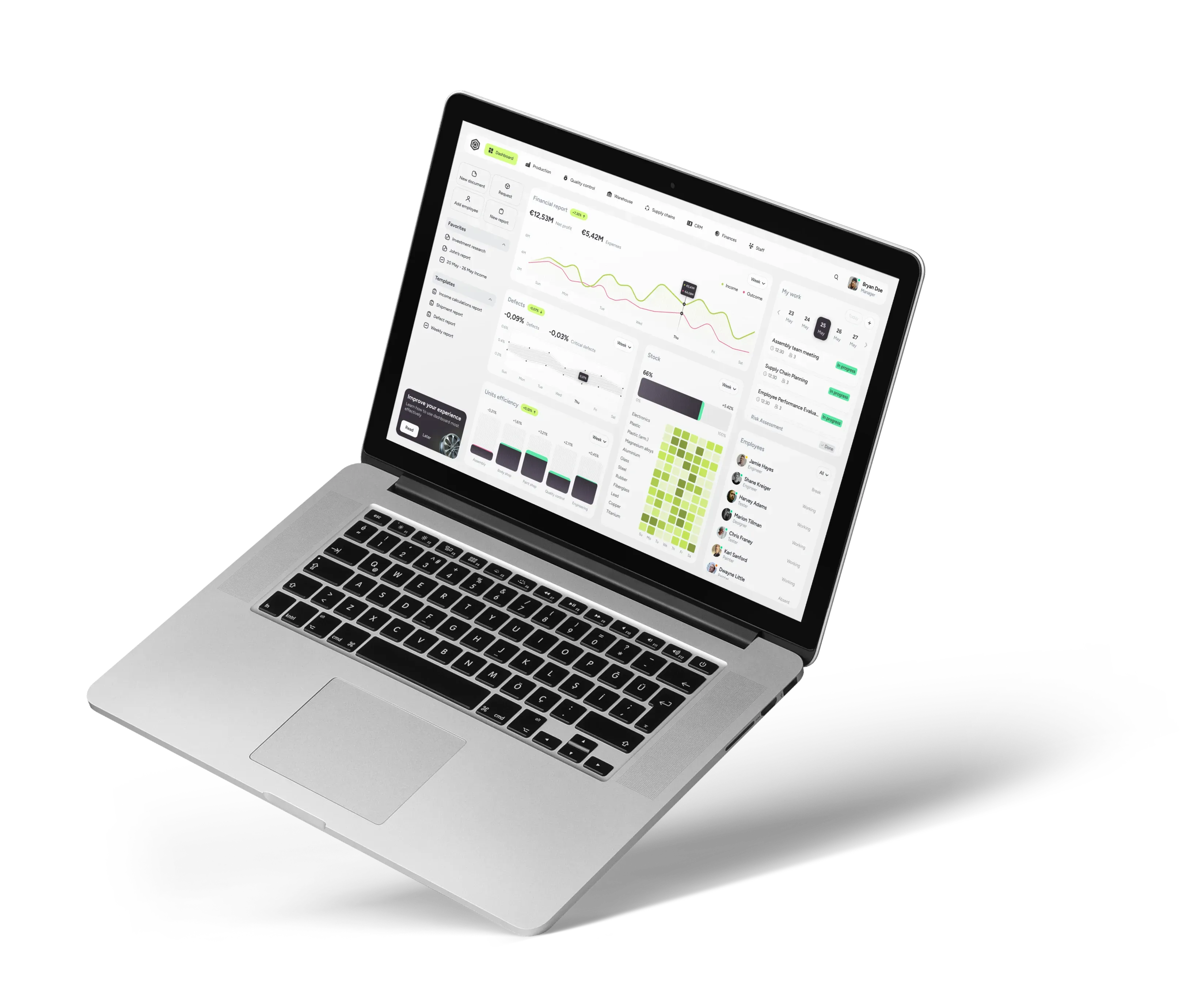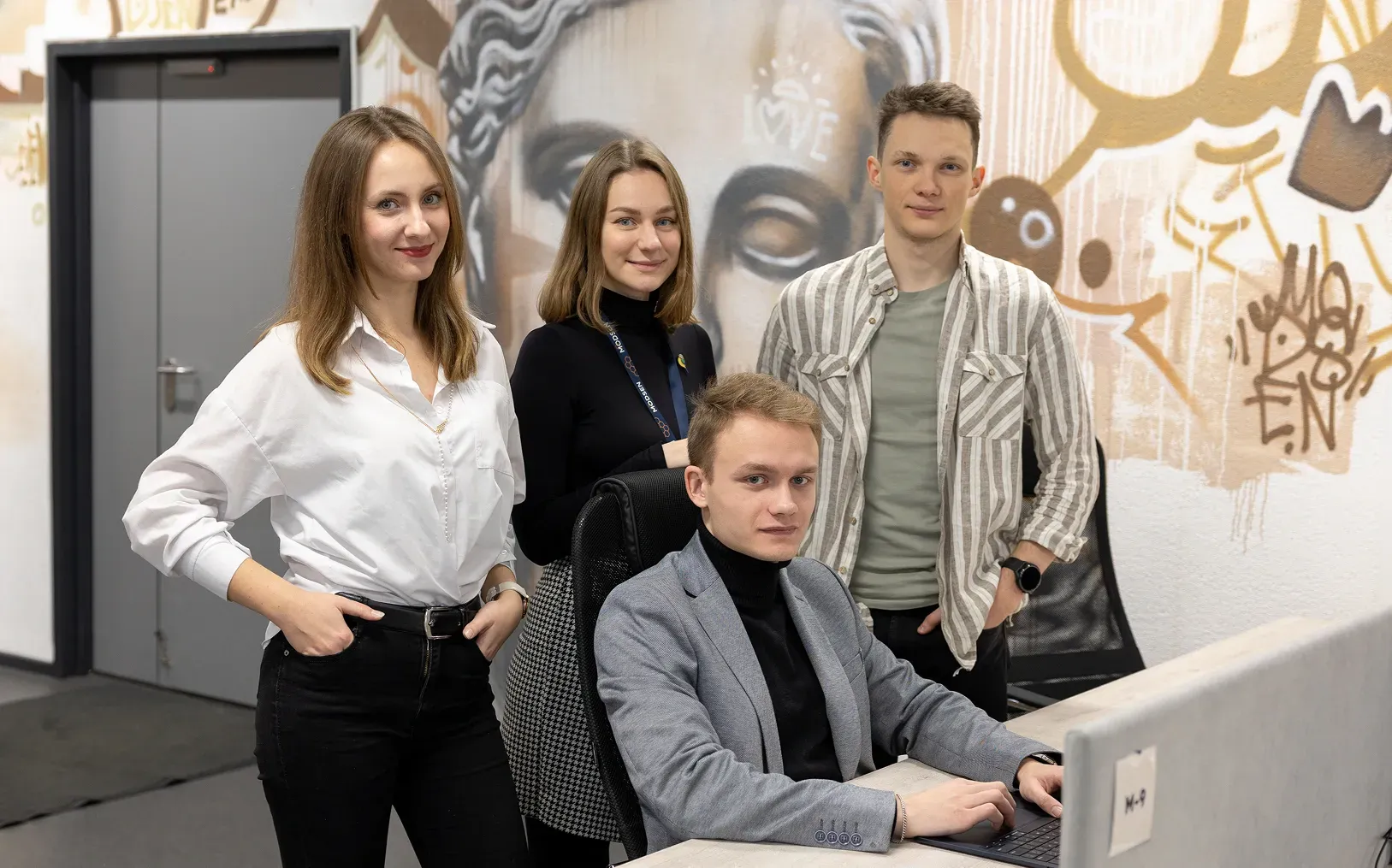
Shift into high gear: EPR for automotive
Follow through step-by-step path of
a multi-module ERP development for car manufacturing
27%
annual revenue growth
33%
savings on redundant operations
45%
more accurate data-driven insights
Challenge
The client's automobile business lacks a centralized system, resulting in operational inefficiencies, rising costs, and difficulties in managing production, inventory, supply chain, and sales forecasting.
Solution
Development of an automotive ERP software with custom modules for production, inventory, supply chain, and sales forecasting, unified by a centralized database.
Tech stack
Client
Our client is a leading car manufacturer in the European automotive market, renowned for its commitment to innovation and high-quality electric vehicles. With a global network of manufacturing facilities and a diverse product portfolio, they sought to streamline their complex operations and enhance efficiency across their entire value chain. Recognising the need for a unified and integrated automotive ERP solutions, they turned to Modsen to develop a comprehensive Enterprise Resource Planning system.
Challenge
The objective of the automotive enterprise management project, focused on ERP for the automotive industry, was to optimise important aspects of the client's operations. This involved integratingion multiple departments, streamlining production planning, refining inventory control, and implementing a robust customer relationship management (CRM) system. The challenge was to deliver these progresses seamlessly and efficiently, with minimal disruption to ongoing operations. The key objectives included:
Departmental Integration: Enable smooth communication and collaboration between departments to update vehicle development, production, and customer service.
Production planning streamlining: Optimise production schedules, minimise production downtime, and maximise vehicle output.
Inventory management refinement: Implement robust systems for tracking and managing parts, components, and finished vehicles, reducing stockouts and abating excess inventory costs.
Customer relationship enhancement: Leverage CRM systems to provide personalised customer service, manage vehicle maintenance schedules, and enhance customer loyalty through tailored communication and support.
Data security and privacy assurance: Protect sensitive data related to vehicle production, customer information, and intellectual property within the automotive ERP system, and ensure compliance with data privacy.

Got a similar software development project on your mind?
Estimate a precise timeframe for its implementation.
Team
1
Project manager
1
Business analyst
1
Team lead
4
Software developers
2
QA testers
2
UI/UX designers

Development process
Requirements gathering and processing
At the beginning of the project, Modsen took the lead in implementing a range of strategic initiatives to guarantee the project's timely and cost-effective completion. One of the most critical undertakings was the adoption of Agile methodology, which facilitated enhanced flexibility, frequent communication, and iterative development to meet the project's objectives effectively.
To develop a comprehensive automotive ERP system for a car manufacturing company, the initial stage of the process involved gathering complete data about the intended system, specific attributes, functionality, outlined objectives, and the necessary level of detail.
Additionally, to gain an all-depth understanding of the client's requirements, we held 3 meetings with stakeholders from various departments, such as manufacturing, finance, human resources, and sales & marketing. During the interactions, we closely examined the company's existing business processes, pinpointed crucial challenges in automotive management, and evaluated their particular needs regarding system functionality.
Planning
With a wide-ranging understanding of the client's requirements, Modsen team moved into the initial phase of the software development process – the planning phase. This involved consolidating all gathered data into a detailed scope of work document, outlining project duration, necessary technology stack, resource allocation (both human and financial), and KPI’s to guarantee 100% compliance with deadlines, budget and scope of work.
To finish off the pre-development step, our business analysts, project managers, and technical experts, collaborated closely with the Chief Technology Officer to develop a sturdy product development strategy, specifically focusing on the client's needs in areas like business process optimisation, service and maintenance, and quality management. The result was a set of comprehensive plan documents presented to the client for approval, concluding the pre-implementation phase and paving the way for the commencement of ERP software for automotive development.
Team assembly
Achieving the project objectives necessitated assembling a team of experienced senior professionals with expertise in automotive ERP system solutions. Modsen's CTO led the team-building process, shortlisting the most viable candidates, conducting internal interviews, and making the final decision. The client then had the option to either approve the proposal or request additional interviews with the proposed project team.
The final team was carefully selected based on their unique strengths and comprised the following members: 1 project manager, 1 business analyst, 1 team lead, 4 software developers, 2 QA testers, 2 UX/UI designers.
Design
The design phase for an automotive ERP system is about creating a sound and extensive system layout that accurately reflects the detailed functional requirements. This included defining data structures, designing user screens, specifying system interfaces and outlining workflows for each functional module. Scalability to handle the complexity of an automotive manufacturing process, data integrity within the single database and seamless cross-module integration to eliminate redundancy and ensure data consistency were key considerations. Modsen Design Studio professionals used modelling tools and visual representations to communicate the system's logic and functionality to stakeholders, ensuring alignment with the overall business objectives and facilitating subsequent development.
Our design specialists embraced the following five key stages:
User research and personas
UX strategy building
Wireframing and prototyping
Visual design
Usability testing and refinement
At the client’s request, we created over 35 mock-ups of the project for this phase. As soon as the final version of the design was complete, the team passed their output to Modsen engineers.

Product building
Modsen specialises in developing innovative, scalable, and reliable software products. Our team of experienced software engineers possess a deep grasp of industry best practices and are constantly looking for new ways to apply cutting-edge technologies. This commitment to innovation was evident in the recent development of an ERP system for the automotive industry.
Drawing on our extensive experience with Angular from over 50 successful projects, our engineers harnessed the framework's powerful capabilities to build a rock-solid and high-performance solution. The collaborative nature of the project ensured seamless communication and timely resolution of challenges. Through a unified team effort and transparent approach, we delivered a high-quality system to meet the specific needs of our customers.
Comprehensive testing
The assurance of a quality-tested product represents the fundamental basis of our work, upon which the entire process is built. In an industry as intricate as automotive, the importance of validation is further underscored. The development of the ERP software for automotive domain underwent a rigorous testing phase, during which our QA specialists evaluated the functionality and integration of the system's various modules. The system's database contains a multitude of integrated functional modules, each of which underwent comprehensive testing before the entire system could be deemed operational and ready for deployment.
The range of tests that are carried out to ensure the highest level of quality for the system covered:
- Functionality testing
- Integration testing
- User acceptance testing
- Security testing
- Performance testing
- Backup and disaster recovery testing
- Usability testing
Integration
Following the implementation of a bespoke ERP for automotive industry, the team prepared the technical documentation and user manual for delivery to the client. Additionally, our project specialists assisted the partner in deploying the software and provided guidance to the product owner on the functions, features, and potential of the newly created application.
Servicing and further cooperation
Modsen aims to foster mutually beneficial and long-lasting relationships with our partners. We believe that long-term collaboration is the best way forward, and we are committed to providing ongoing support and flexibility to meet the evolving needs of our partners. Developing a prosperous automotive ERP system for our partner is a long-term endeavour that requires our dedication beyond the implementation. Even after the ERP system has been launched, we remain actively involved to provide constant service and maintenance, support and guidance. This ensures that the system remains robust, efficient and scalable.

Result
The automotive enterprise management project achieved resounding success, delivering a significant transformation for our client. By seamlessly integrating departments, optimising production planning, streamlining inventory control, and implementing a robust CRM system, we achieved a holistic improvement across the client's operations.
27%
Surge in yearly enterprise revenue33%
Cut in costs for redundant operations45%
Gain in accuracy of data-driven insightsLet's calculate the accurate cost and resources required for your project




